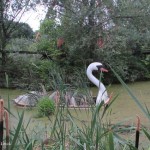The Wild East
Living in Berlin one cannot escape history. The history of Germany in the 20th century is everywhere in the city and even if many of the scars of WWII and the Cold War have been obliterated, they are still there if you seek them out.
Last weekend I had two very contrasting experiences – both to do with the history of the GDR about which I know next to nothing. Our family didn’t have any close relatives in the East and as we were living almost as far West as Holland, there were no daily reminders of a country split in two.
I first went to see a play called “Spuk unterm Riesenrad” – an adaptation of a GDR children’s classic in a former amusement park which had been a huge attraction in Berlin but has since fallen into disrepair, a victim of speculation and changing tastes in leisure activities. Many of the former GDR attractions are struggling as they were mostly huge and much centralised, my local sports centre is in a similar predicament. The amusement park has its own charm in its current state and much interest from visitors but nobody knows exactly what will happen to it. Much of it has been left to the elements and reclaimed by nature and the remaining attractions are in such a poor state that they can’t be saved. Vandals, thieves and taggers have also done their bit to destroy what remains. Nevertheless, it was a most fascinating place to visit and even though I only saw a small part, I would love to go back!
On Sunday a friend of mine suggested a trip to the “Gedenkstätte Hohenschönhausen”, a former Stasi prison and interrogation centre. A fascinating visit! We arrived on our bicycles at a forbidding looking complex with watchtowers, barbed wire and high walls still in place. The guided tours are run by former prisoners, all with their own stories to tell, keeping the memories alive of a building used for incarceration from the end of the war. The earliest part was built by the Nazis as a kitchen during the war and then used by the Soviets as a detention centre. The East German state security apparatus took over in the 1950s and started building a huge centre which was totally cut off from its surrounding neighbourhoods. The low-rise family homes and high rise tenements surrounding the site were reserved for personnel and according to our guide the entire area was a blank on maps at the time. This high level of security unfortunately also allowed the Stasi time to destroy papers when the East German state collapsed but the location speaks in many ways for itself. The cells, the interrogation rooms, the traffic light systems throughout the buildings to ensure that no prisoners would ever meet on their way to and from their interrogators, are all stark reminders of a dictatorial surveillance state which didn’t trust its own citizens.
Both places are definitely worth a visit even though the jury is out at the moment on the fate of the former amusement park. In the meantime I can at least show you a few pictures of both which I hope might whet your appetite!








